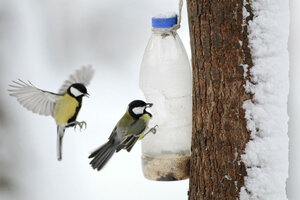New study shows us what 'lovebird' really means
Scientists at University of Oxford found that great tits value their relationships more than food.

Great Tit birds feed on nuts and seeds left by visitors in a bird feeder in a park in central Minsk, Belarus.
Vasily Fedosenko/Reuters/file
Scientists have found that even wild birds do crazy things for love. In studying mating pairs of great tits, or Parus major, researchers at the University of Oxford in the UK found that the small songbirds gave up access to food to stay close to their partners.
Though these birds already sacrifice some access to food to forage in flocks, which helps protect them from predators, scientists thought that tits who are mating would split up if that meant greater access to food. By restricting access to feeders to one bird in mating pairs, researchers found that the bird without access to a feeder still spent significant time there, alongside its feeding partner.
In a recent paper in the journal Current Biology, researchers from Oxford’s Department of Zoology say their study shows that love influences the great tit’s foraging behavior.
“The choice to stay close to their partner over accessing food demonstrates how an individual bird's decisions in the short term, which might appear sub-optimal, can actually be shaped around gaining the long-term benefits of maintaining their key relationships,” said study lead Josh Firth, an Oxford zoologist.
Like humans, birds stay in exclusive mating relationships for many seasons. Since great tits need their partner to reproduce and raise their chicks, the choice to skip meals to maintain their relationship seems to be a worthy tradeoff.
Researchers tested this by setting up bird feeders in the woods near the university, each releasing seed only to birds tagged with a radio frequency code that triggers the release. Half of the feeders opened only for even-numbered tags on the birds, and half opened only for odd-numbered tags. Some bird pairs had matching tags allowing them to eat from feeders in the same area, and other pairs had non-matching tags, which meant the doors would open only for one of them.
The study found that when pairs visited feeders they couldn’t both use, they spent more time there.
“Some birds would get away with mainly going to their preferred feeder, and having its partner following it there,” said Dr. Firth. “The flipside of this, of course, is that it means some birds pretty much spent all of their time at a feeder they were not allowed access to, just because its partner was going there,” he added. This was regardless of gender, he said.
But the committed birds didn’t necessarily go hungry, Oxford researchers found. Instead, the pairs seemed to cooperate, exploiting a feature of the feeder technology that allowed the seed release gate to stay open for a couple of seconds at a time. By acting quickly, both partners in a pair could eat some seed before the feeder closed.
Firth and his colleagues say that partners even seemed to be deliberately helping each other, reported Discover magazine.
“This may have widespread implications, particularly as changes in foraging associations carry over into other social contexts,” study authors wrote.
Understanding more about their social structures can provide insight on how diseases and information are spread through bird populations.

